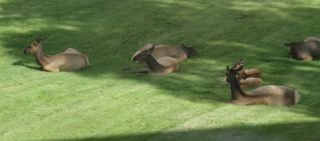
Environment
Are We Being Set Up For Fatal Mistakes?
Documentary television shows and films often mislead viewers about reality.
Posted October 12, 2012
I have long appreciated Walt Disney and his company for putting so many wildlife shows on the television, long before Animal Planet and other channels picked up the habit. But I am beginning to think the family-friendly animal shows have done us a huge disservice.
I recently spent a glorious week in Yellowstone National Park, one of this country’s treasures. The scenery, the animals, the wildness – all were superb, better than I remembered from my last trip. But I saw a few things that gave me pause.
First and foremost, the other visitors were sometimes remarkably stupid. I know no other, kinder descriptor for people who steadfastly ignore signs, communications from those more knowledgeable than themselves (like park rangers and wildlife guides), and common sense. What can I say about the man who got gored by a bull bison – 2000 pounds of unpredictability, power, and territoriality – because he went up to the bison, pawed the ground with his foot as if he were a rival bison, and stuck a camera in the bison’s face to get a stunning shot? Yes, it was stunning. Pushed beyond endurance, the bull tossed his massive head aggressively, catching the visitor with its horns and flinging him through the air to land, hard, on the pavement. I heard the man’s shout and turned to see him on the ground, with many people rushing over to help him. He was taken to the hospital by ambulance with, at the very least, cuts, bruises, and broken bones.
How could this man ignore the signs that told him to keep 25 yards from any wild animal? This is not advice delivered once, low key, when you enter the park. Visitors are warned over and over in every possible format to stay a safe distance from animals. In fact, bison injure more visitors than wolves.
But no, this guy wanted that special shot.

A bull bison courts a female with bellows, "bouquets" of vegetation caught on his horns, and devoted attention.
The same was probably true of the people who got out of their cars to watch courting bison by the roadside. When warned to get inside their cars by rangers, these visitors stood behind the open door to their cars. I wanted to point out that if the door got hit by 2000 pounds of bull bison traveling 30 mph, they were going to be meat paste, squashed between the door and their car. Or, if lucky, they might lose only their feet and head. Is the risk worth a slightly better photograph?
Over and over, I saw visitors closely approaching 1000-pound mother elks with their babies. Even a thoroughly domesticated animal can be vicious if its babies are in danger. Do people understand nothing about mothers defending their offspring?

I photographed this mother-and-baby herd of elk from a safe distance, through my hotel room window.
Another visitor, during the same week, stepped off the boardwalk in one of the thermal areas. He crashed through the solid-seeming crust, fell into a boiling mud pot, and was airlifted to a burn center in serious condition. He had been told, only moments before, to stay on the boardwalk. Signs were everywhere, too. He thought he knew better and did not.
One excellent and kind wildlife guide suggested to me that people get so excited to see the animals or the thermal features that they forget what they have been told. That may be true. I was overwhelmed by the animals and places I saw. But I think there is another factor at work.
Most of us were brought up on Walt Disney, Animal Planet, and numerous documentaries and specials about wilderness areas. Animals are cute and personable; they move through the landscape to bouncy, cheerful music; and nothing ever dies – or, in the rare cases where an animal does die, it does so discretely off camera. We never see the essential ugliness of life in the wild and the very real struggle for survival. We are shown only the sweet, palatable events in the annual cycle of whichever species is focused upon. We never see the starvation and disease that a hard winter may bring or the wounds caused by combat with other animals for territory or mates. We see only the beauty, not the dangers.
While I understand why television producers prefer “nice” stories, I think it does the public a great disservice. Too many viewers think these films are realistic depictions. The images we are given of wild animals are usually positive, often beautiful, and they feel educational. Being bombarded with such images leads to serious and sometimes fatal mistakes that occur when people underestimate wild animals and wild places. We are conditioned by these shows to think wild animals are exotic and impressive but somehow safe and charming. Wild animals are wild and that means ferocious, unpredictable, and aggressive when threatened (as they see it, not as we do).
Can’t we aspire to a higher level of education in our so-called documentaries about wildlife and wild places? The beautiful, majestic wolves so many people love and admire are also relentless killers; to think otherwise is to fool yourself. The great, solid, black bison that dot Yellowstone’s meadows also charge and gore, each other as well as tourists. The soaring bald eagles that look so amazing rip and tear their prey to shreds.
Can’t we accept that the world is not always safe, predictable, and comfortable? Do we wave to sanitize and regulate the wildness into extinction? I hope not. Losing touch with nature is losing touch with ourselves.

